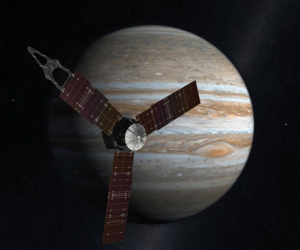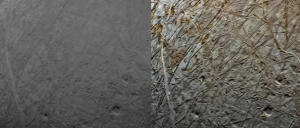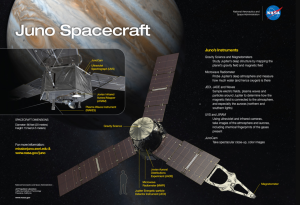Juno Mission

The image above illustrates an artists’ perception of Juno.
Source: NASA
Overview
The Juno spacecraft left Earth on August 5, 2011. It reached its destination, Jupiter, on July 4, 2016. The spacecraft’s journey stretched 5 years, traveling 1.7 million miles.[1] The mission objective is to uncover answers to the mysteries regarding Jupiter’s origin and evolution. Jupiter may hold the key to unlocking the circumstances of our solar system’s creation.[2]
Learning about the formation of Jupiter is an essential part of understanding how Earth was formed. Giant planets like Jupiter are considered the “cornerstones of planet formation.”[3]
Over three terabits (375 gigabytes) of information was collected during Juno’s initial mission. Scientific observations have unearthed information about Jupiter’s atmosphere, in addition to its interior. This data has updated the way NASA views the giant planet, as well as, the formation of solar systems Various explorations were conducted, such as:
- Exploration of a solid planetary core
- Magnetic field mapping
- Deep atmospheric measurements of water and ammonia
- Study of planet auroras[4]
NASA uses JunoCam, a specialty camera for public outreach, to provide visuals of Jupiter during the mission.[5] Citizen scientists process the images and the final products are recognized as a combination of science and art.[6]
The Juno image gallery provided by NASA can be found here. The raw form of images from JunoCam can be found by following this link.
JunoCam image processing can take shape in a variety of ways. The image below depicts the same image of Jupiter’s moon, Europa, processed differently. The photo of Europa is slightly processed on the left-hand side, but on the right-hand side, the image is heavily contrasted to differentiate between surface features.[7]

Source: NASA
The Juno spacecraft is currently in an extended mission as it remains in exploration of the Jovian system.[8] Jupiter has many moons. Of Jupiter’s 80 moons, NASA identifies lo, Europa, Ganymede, and Callisto as the moons with highest scientific interest. Additional information about Jupiter’s moons can be found here.[9]
During Jupiter’s extended mission, flybys of Europa and lo moons are planned. The spacecraft will also pass through lo torus and Europa torus (charged particles that form doughnut-shaped clouds which envelop lo and Europa’s orbits.)[10]
The spacecraft is assisting NASA’s Europa Clipper mission, as well as the European Space Agency’s JUICE mission during its extended time in space. Juno assesses the radiation environment and the information gathered will better equip those who develop science priorities, observation strategies, and mission design for future missions. The Juno spacecraft will also explore Jupiter’s faint ring dust while on its extended mission. The Juno mission is projected to end at the spacecraft’s end of life or September of 2025.[11]
Spacecraft and Instruments

Source: NASA
The scientific payload for Juno is made up of:
- “A gravity/radio science system (Gravity Science)
- A six-wavelength microwave radiometer for atmospheric sounding and composition (MWR)
- A vector magnetometer (MAG)
- Plasma and energetic particle detectors (JADE and JEDI)
- A radio/plasma wave experiment (Waves)
- An ultraviolet imager/spectrometer (UVS)
- An infrared imager/spectrometer (JIRAM)
- A visible color imager (JunoCam)
- A stellar reference unit (SRU)”[12]
Juno’s spacecraft is easily controlled due to its spinning, solar design. During each rotation in orbit, the field of view of each instrument is passed once. The spacecraft conducts two rotations during each minute. This is equivalent to 240 passes in two hours (the amount of time necessary for Juno to get from one pole of Jupiter to the other).[13]
Juno’s spacecraft is solar powered, and its three solar panels feature considerable surface areas to accommodate the distance between Juno’s spacecraft and the sun. When its solar panels are extended, the spacecraft is around 66 feet (or 20 meters). Solar cell design has advanced in the last 20 years, providing Juno with silicon cells that can withstand more radiation than their predecessors. Another benefit for Juno, is the amount of power its instruments need. The instruments only need full power for a small number of hours in every orbit. Juno features a radiation shielded electronics vault, the first of its kind, that helps the spacecraft continue traveling through Jupiter’s high radiation. The spacecraft also circumvents regions with the most radiation.[14]
Team
The Juno mission’s team organizational chart can be found here.
Principal Investigator: Dr. Scott Bolton
Deputy Principal Investigator Dr. Jack Connerney
Project Scientist: Dr. Steve Levin
Science Investigation Office: Cyndi Kempe[15]
Recent news
In September 2022, NASA released an image of Juno’s pass by Europa (Jupiter’s moon). The image was captured from around 219 miles (352 kilometers) away. The Juno spacecraft traveled at a relative velocity of 14.7 miles per second and had a small number of minutes to capture any information, including images, as it passed by Europa. Future mission, Europa Clipper, plans to address questions about Europa’s habitability, breadth of its ice crust, atmosphere, surface, and interior. In addition, there will be exploration into the emission of water from Jupiter’s subsurface into space, by way of potential plumes.[16]
Updated November 2022 by Jackie Johnson

Comments are closed.